|
“This is another of the remaining open
trestle post mills. It is in bad condition. One of the sails remains
with its end resting on the ground, and so helping to support the
body of the mill. It ceased working before the war . . . . This is
one of a group of mills with three, instead of two cross-tree
timbers, and six, instead of four quarter bars [Chinnor
being another] . . . . This mill is not
marked on an old map of 1797, and as its appearance suggests a
greater age than one is led to suppose, it may have been brought
from elsewhere and erected on its present site.”
English
Windmills, Vol. 2, 1932.
Piecing together a windmill’s history is usually much more of a
challenge than locating it, for windmills rarely attracted much
attention during their lifetime and it is not unusual to find that
little or no documentary evidence survives. Nevertheless, when
taken together, parish records, local trade directories, newspapers,
auctioneers’ catalogues and letters of the period can sometimes
provide a sketchy outline, as this chapter illustrates. Then
there are old books; fortunately, enthusiasts such as Stanley
Freese, Rex Wales and Donald Smith were around when windmills that
are now long gone were still to be seen — even if only their remains
— and they recorded for posterity what they saw and learned about a
windmill’s history, usually from people who could remember the mill
at work, or even worked in it.
Thus, what follows is sometimes little more than a mention of
some of the undoubtedly many windmills that once worked in
north-west Hertfordshire and over the county boundary into parts of
Buckinghamshire.

Fig. 14.2: Cuddington
post mill near Aylesbury, seen in 1894.
This post mill was demolished c.1925.
TRING
From the time of Domesday until the middle of the 16th century,
streams in and around Tring drove three different watermills; so it
can be assumed that in medieval times there was probably no need to
erect any windmills, or if there were any they are unrecorded.
The watermill at Gamnel was bought by the Grand Junction Canal
Company to acquire its water rights, but when the other watermills
fell into disuse is not known. The first windmill map symbol
for Tring appeared in 1766 on a map surveyed by the famous
cartographers Dury and Andrews.

Fig. 14.3:
c.1766 —a windmill symbol is at the centre of the map, under ‘New
Mill’ (an area of
Tring which has retained that name) and to the right of the
intersection of the present day
Dundale Road and Icknield Way.
The windmill depicted on this map (fig. 14.3) was sited three
quarters of a mile north of the parish church, on the Icknield Way
and to the east of what is now Dundale Road; on the map, the area is
called ‘New Mill’, a name that it has retained. A windmill is
also shown in this position on the Inclosure map of 1797; valued by
the Commissioners at 6s.2d., it is listed as belonging to Edward
Foster’s Trustees. No other records of Tring’s old windmill on
Icknield Way are mentioned in any local records. The late
local historian Bob Grace, who owned Grace’s Maltings in Akeman
Street, claimed that a 3ft ‘Cullin Stone’ (a name given by millers
to black millstones imported from the Cologne area of Germany) from
this old post mill was set into the courtyard of his premises.
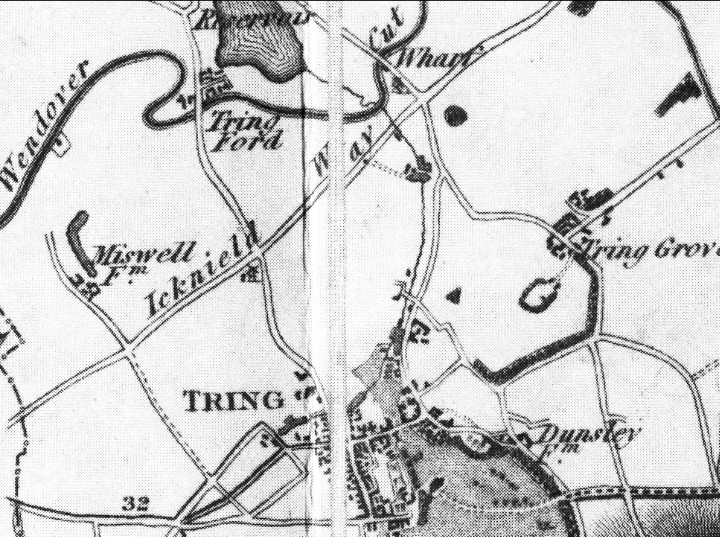
Fig 14.5:
Bryant’s Map of 1820. A windmill (unknown) symbol appears
under the “eld”
of Icknield.
Before leaving Tring, it is worth mentioning that a windmill symbol
appears on Bryant’s Map of 1820 (fig. 14.5). It is also
located on Icknield Way, but further west than the ‘New Mill’
mentioned earlier, at the junction with Dundale Road. This
symbol might in fact refer to the ‘New Mill’, with either Bryant’s
or Dury & Andrews’ map containing an error as to its location.
It is also possible that Dury’s map might correctly mark the
location of an entirely different mill of which nothing now is
known, or that the ‘New Mill’ was moved.
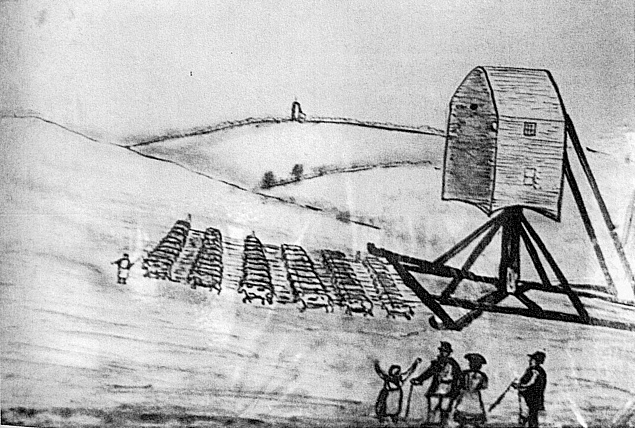
Fig. 14.4:
moving a post mill using a sled hauled by a team of oxen.
Although uncommon, windmills were moved occasionally, as this
account of the procedure for bodily removing a post mill illustrates
. . . .
“If the main post and crosstrees were to be
retained, they might be removed complete with the mill carcass; the
crosstrees [fig. 2.2]
would be shored up, brick piers demolished, and the trolley run
underneath the structure, which was then let down bit by bit with
jacks and levers. Sometimes in Suffolk two ‘drogues’ (or
timber wagons) were lashed together side-by-side, two arms of the
crosstrees being rested on one, and two on the other . . .”
. . . . and many horses or oxen were then teamed to haul the
resulting load. But were the mill was to be moved any
distance, this could only be achieved by dismantling it; an example
here is the smock mill at Lacy Green, which originally stood at
Chesham. In 1821, it was dismantled and reassembled some
9-miles to the west on its present site at Lacy Green (Chapter
XIII).
ALDBURY
In Aldbury the Open Village, (pub. 1987), Jean Davis, the
Aldbury historian, writes that . . . .
“. . . . in the southwest corner of Aldbury
Parish, Great and Little Windmill Fields recall the mill which would
have served Pendley Manor, but as early as 1354 it was in very bad
condition.”
Two maps of Aldbury, one dated 1762 and the other 1803, show a
‘Great Windmill Field’ and a ‘Little Windmill Field’ in an area
about one and a quarter miles south-west of the church. These
fields are near both the Tring and Wigginton parish boundaries with
Aldbury, and an account of the bounds of Tring Manor in 1650
contains what seems to be a reference to this windmill site. . . .
“. . . . and soe a longe the highway
between Aldbury ffield and Tringe ffield and soe to Pendley
Lockshops and from thence unto Pendley gate and from thence to
Windmill Corner and from thence to old well . . . .”
These references to known landmarks locate ‘Windmill Corner’ as
adjacent to the ‘Windmill Fields’.
Even more mystery surrounds the second windmill in Aldbury. A
rental document, with an approximate date of 1501, mentions a “wynd
Milfelde”, the site being about two-thirds of a mile
west-north-west of the church. Further evidence of a windmill
in this position comes from a map of the Duke of Bridgewater’s
estate dated 1762 which names a ‘Windmill Hill’. On an aerial
photograph of 1972, there is a circular crop mark in the position
where it is thought to have been sited.
A further shred of evidence can be found in the Victoria County
History of Hertford (Vol.2), which states that a windmill was
erected in Aldbury towards the end of the 16th century. In
1589-90, a licence was asked for by Thomas Kynge to erect a cottage
for the miller “a painfull man in his calling”. This
latter does not quite agree with the other dates, but in discussing
matters so long ago, a difference of one hundred years has sometimes
to be expected; all that is certain is that there has been no
working windmill at Aldbury for a very long time.
PITSTONE’S OTHER WINDMILL
The post mill at Pitstone (Chapter VI),
now in the care of the National Trust, is well known and documented.
What is less known — indeed, almost unknown — is that it once had a
near neighbour, another post mill, which was located on land that is
now part of the Castle Mead estate.
The sole documentary evidence for this mill lies in an account
written during the 1930s by the author on windmills, Stanley Freese.
Freese admits that the mill is not shown on standard maps of the
period, “although the early 6in and 25in O.S. outlined the mill
mound without naming it”. However, local historians at
Pitstone Green Museum were able to locate the mill on an undated
tithe map, standing adjacent to the course of the former Marsworth
to Pitstone Road.
Freese’s single type-written sheet gives a brief account of an
interview that he had with one John Tompkins, whose family drove the
mill. Tomkins told Freese that his father “had the mill
until about 1861” when he left for America and that the mill met
its demise shortly afterwards. In Freese’s words. . . .
“Mr. Tompkins believes that the late Mr.
Hawkins, who eventually had Ivinghoe Mill [the National
Trust mill], took the old one from his
father, but in any case it would have been only for a year or two;
for the mill ‘ran away’ in a gale whilst the miller and an old man
named Corkett were in it; and before it could be checked two of the
sails were hurled from the mill. The miller anticipated the
catastrophe and shouted to Corkett to look out, but the latter being
very deaf did not hear the miller’s shout above the gale; and found
the roundhouse, in which he was at work, falling about him, and a
sail coming through the roof. He escaped serious injury
however.”
Such were the risks of windmilling, and it is coincidental that
Pitstone windmill was to meet with a similar catastrophe in 1902.
The mystery mill must have been badly damaged, for it was demolished
shortly afterwards. John Hawkins, a local farmer interviewed
by Freese, had known old Corkett and although he did not recall the
mill he did remember that its brick piers remained for a time before
they, the mound on which the mill stood and its access path, which
lay adjacent to the old Ship Inn in Vicarage Road, disappeared under
the plough.
The description given to Freese was of a post and roundhouse
structure of average size, but not as big as Pitstone Mill,
nondescript in colour, with four cloth sails and a tail post and
wheel. It was equipped with both wheat and barley stones, side
by side, but it is thought not to have been a flour mill but
employed in grinding animal feed. The mill is believed to have
belonged to the Ashridge Estate and Freese thought it possible that
the Estate later purchased Pitstone Mill to replace it.
CHOLESBURY
Yet another mystery windmill was sited on the east side of
Cholesbury Common. This is shown on Robert Morden’s 1695 map
of Buckinghamshire and also that of his copyist Emanuel Bowen’s map
of 1760. About a furlong south of Tring Grange Farm, the
position marked is now just over the Hertfordshire border.
According to local tradition, the exact site was not ‘Windmill
Field’, which would place it on a hillside, but in the next field
upon the hilltop. However, at the time of writing it remains a
mystery, for no remains have been discovered.
HAWRIDGE COMMON
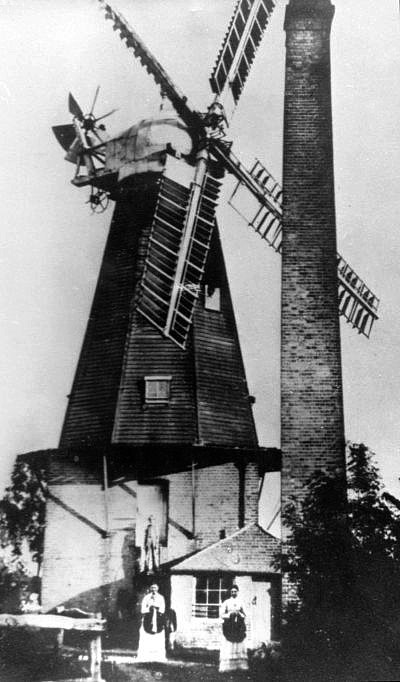
Fig. 14.6:
Hawridge smock and steam mill.
In the words of Stanley Freese, a “fine-looking though not well
designed smock mill” (fig. 14.6) was erected on Hawridge Common
by the ‘Norwich Wind and Steam Mill Company’ in 1863, and came
complete with steam engine to supplement the wind; old photographs
depict an impressive brick chimney and, by 1866, a delivery note for
half a sack of flour (at 18s.0d.) was headed “Hawridge Wind and
Steam Mill”. The chimney was pulled down in 1884.
Hawridge smock mill was unusual in Buckinghamshire in having a
square two storey brick base, above which was a narrow wooden tower
whose walls were tarred. The four white sweeps were of the
patent anti-clock double-shuttered type, and the fantail was
six-vaned.
There is no continuous and completely reliable record of the various
millers and owners of Hawridge. The Millers who can be traced
through the census returns are . . . .
|
1861 |
Thomas Moreton, miller, born
Nuneaton
Charles Pedel, journeyman miller, born Wendover |
|
1871 |
Joseph Salt, miller, born
Congleton
George Salt, miller, born Warwickshire
George Wright, miller, born Cholesbury |
|
1877 |
William Wright, miller |
|
1881 |
Harry Wright, miller, born
Tring |
Original documents show that the mill was acquired in 1871 by
Humphrey Dwight, described as a pheasant breeder from Wigginton, who
purchased it from a consortium at Great Windsor. He paid £700,
which included “a messuage, granary and premises”, the legal
aspects of the sale being handled by Smith, Fawdon & Low of Chesham
and Shugar, Vaisey & Co. of Tring.
It seems that Dwight did not prosper, for ten years later the
freehold again changed hands. Dwight (described in the 1881
Census as a farmer of 140 acres employing 5 labourers, and resident
at 24 Bellingdon Road, Chesham) called again on the services of
Tring solicitor, Arthur Vaisey, who prepared on his behalf the
following statement dated 14th February 1881 . . . .
“I the undersigned Humphrey Dwight of
Bellingdon near Tring having been served with a Writ for the sum of
£578.5s.2d. due from me for principal and interest to the executors
of the late Mr John Merritt Shugar which sum is charged upon my
freehold mill and premises situate at Hawridge Bucks hereby
authorise and request you to take the necessary steps on my behalf
for selling the said mill and premises either by public auction or
private contract and also to endeavour to get any further
proceedings on the said Writ stayed pending the sale of the
property.”
On 26th February, William Brown & Co. received instructions to
auction the mill, the sale being held at the Rose and Crown Inn,
Tring. The auctioneers described the property as a . . . .
“Free hold Windmill with steam power
attached, driving four pairs of stones, situate on Cholesbury
Common, part in the Parish of Cholesbury, part in the Parish of
Hawridge; also capital residence with garden, yard, and stabling.
The property is in the occupation of Mr Wright, a yearly tenant at a
rent of £400 p.a.”
The sale realised exactly £600, which Humphrey Dwight was obliged to
surrender to settle the debt together with a further £20. 18s. 5d.
to cover auctioneer’s and solicitor’s fees.
The mill is believed to have been bought by Daniel, another member
of the extensive Dwight dynasty, who at some time between 1881 and
1883 replaced the smock mill with the tower mill (Chapter
IX) that stands today. The reasons for demolishing a mill
only twenty years old were given as inconvenient arrangement; poor
construction; loading floor on the ground instead of at cart-level;
and no bin floor, resulting in grain having to be fed directly into
the eye of the millstones instead of being shot down from storage
bins in the floor above. These defects probably rendered the
mill unprofitable to work, and might in turn explain the frequent
change of millers. But one miller is known to have given up
the mill for an unrelated reason. Joseph Salt met a tragic
death when, helping to right a derailed locomotive in the
neighbouring Tring valley, he failed to let go of a lever when it
was released by the other workmen, and was killed as a result.
During its demolition, the smock mill’s machinery and other parts
were salvaged to be incorporated in the new tower mill. Today,
a fitting reminder of Hawridge’s old smock mill lives on in the
shape of the logo of the Hawridge & Cholesbury Cricket Club, whose
members are fortunate enough to have a pitch on the beautiful
Common.
MARSWORTH
The Domesday survey records three mills in the Manor of Marsworth.
By 1292 a water mill existed, valued at £4. 9s. 4d., which descended
through various owners, eventually becoming known locally as Dyer’s
Mill. It stood in the south-west corner of the village, and
according to the Victoria County History (Vol.3), it was “turned
into a windmill”, which seems quite possible since the
construction of the Grand Junction Canal diverted the water, thereby
incapacitating all Marsworth’s watermills.
A reference of 1817 records that a Thomas Sear insured a brick and
timber wind-driven corn mill with no kiln and two pairs of stones
for £600 and an adjoining house for £200, the whole a quarter of a
mile west-south-west of Marsworth church. In 1824, members of
the Sear family leased the premises to William Pickett, shopkeeper
of Marsworth. These included “a recently erected windmill
on the same site of the former watermill”.
Twenty years later Thomas Sear sold the mill to a horse dealer,
Charles Gregory, who took over the £400 mortgage. After a few
years it was sold on again to Thomas Clarke, miller of Tring, who in
his turn took over the mortgage and insurance payments, also
obtaining a second mortgage of £1,000 to erect a steam mill “adjoining
to the said Wind Corn Mill”. The Indenture included a
requirement to keep “the wind corn mill insured against loss or
damage by fire, and to run the business correctly”. By
1875 the mortgage was paid off.
Thomas Clarke died intestate, and his property was offered for sale
at the Rose & Crown, Tring; Thomas Mead, a local miller, bought the
entire premises for £1,500. According to the sale
advertisement that appeared in the Bucks Advertiser during
January, 1881, it comprised . . . .
“. . . . a Steam Mill of 5 floors fitted
with a 12 hp. Steam Engine, a 16 hp boiler, 3 pairs of stones with
elevators, and all necessary shafting and gearing, most completely
fitted, and all in perfect order; a SIDE MILL of 4 floors,
communicating therewith from each floor; a bean and drying kiln; a
comfortable dwelling house, adapted for the proprietor with all
necessary fittings; a stable for 4 horses, with loft over; various
convenient out-houses; good garden; close of pasture and orchard
land, together about one acre, one rood, and one pole, upon which a
lucrative business has for 28 years past been carried out . . . .”
Thomas Mead already owned a new
steam-driven mill at Gamnel Wharf, Tring, and bought Marsworth
windmill possibly as a strategic purchase to prevent any competition
with this new venture. However, he had no use for the old
windmill which was eventually demolished c.1919.
Elderly residents of Marsworth, when interviewed during the 1930s,
recalled that the windmill’s sails were torn off in a gale in about
1845 and the gear so damaged that for a considerable time the mill
was unworkable. A man who assisted with the demolition
remembered it being built of red brick, four storeys high but
without a stage, and with four patent sweeps and the usual fantail.
OTHER VANISHED WINDMILLS
|
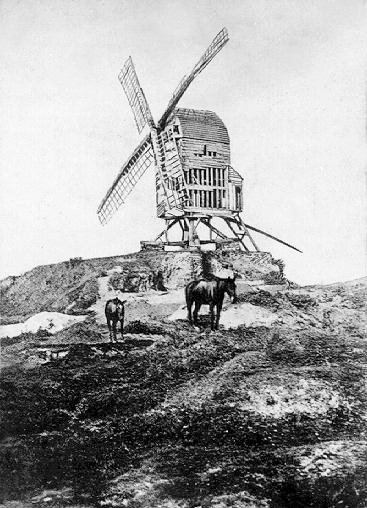 |
|
Fig. 14.7:
Parson’s Mill, Brill. |
In his book Hertfordshire Windmills and
Windmillers, Cyril Moore refers to several windmills in the
broad locality of Tring about which very little is known. That
at Abbots Langley, believed to have been in the vicinity of Catsdell
Bottom, was standing in 1912 in a derelict condition. There is
evidence of two windmills at Berkhamsted, one of which, a post mill,
is depicted in an 18th century view of the town that places it in
the vicinity of Millfield Road. The windmill at Little
Gaddesden probably disappeared in antiquity, with old references to
a “Mill Field” to the south-east of the church being its last
trace.
To the north of Tring, there were windmills at, among other places,
Brill and Quainton — in addition to those that remain at both
locations — and at Wing, Wingrave and Waddesdon.
At Brill, the famous post mill that stands on the Common once had a
near neighbour. Built in 1634 and latterly known as
Parson’s Mill, it stood on the opposite side of the road.
Unlike its neighbouring post mill, Parson’s Mill did not have
a roundhouse, but at the time of its demise and on the grounds of
comparable age, the two mills were probably similar in other
respects. Struck by lightening in 1905, the mill was
demolished in the following year; the mound (‘tump’) on which it
stood (seen in the photograph) remains visible.
|
 |
|
Fig. 14.8:
Waddesdon mill stood on Windmill Hill. |
There is no record of when Waddesdon Mill
was built, although it was standing in 1834, for in Cook’s
History of the English Turf the author describes a steeplechase
run in that year over a course from Waddesdon windmill to Aylesbury
Church, while from a slightly earlier period the account book of the
Aylesbury millwright William Cooper (Chapter
V) records that he undertook work on a windmill at “Wadsdon”;
it is also believed that John Hillsdon of Tring was in some way
connected with the mill. [6]
The mill is said to have been a particular favourite of Miss Alice
de Rothschild, who had inherited the great Waddesdon estate from her
brother, Baron Ferdinand. In its latter day this attractive
tile-hung windmill was said to be more ornamental than practical,
for local rumour has it that if the wind was favourable it was set
to work for no better purpose than to greet Miss Alice on her return
to the village after her absences abroad, and she is believed to
have paid for its restoration in the early years of the 20th century
(c. 1905). English Windmills (Vol. 2) records that
(c.1930) the mill was “slowly decaying”; according to Stanley
Freese, it met its fate when “it was dynamited by the Baron’s
nephew for no apparent reason in the summer of 1932”.
The history of the fine tower mill that stands near the village
green at Quainton is well known; much less is known about the
village’s other windmills, of which there were several over the
centuries although only scant references to the earliest of them
exist.
The first windmill about which there is firm information stood at
Blackgrove Farm to the south-west of Quainton village. Owned
by Thomas Anstiss, who later erected Quainton tower mill (Chapter
XI), ‘Banner Hill Windmill’ opened for business on the 16th May
1797, having been erected in the short space of 57 days.
Following completion of the tower mill, Anstiss sold Banner Mill,
which was later dismantled and moved to Mursley (c.1840) where it
continued in operation until the 1890s, when it burned down in
mysterious circumstances.
Another post mill, ‘Curtis’s Mill’, named after its owner Thomas
Curtis, stood at Quainton on Seech Field near to the railway
station. Built towards the end of the 18th century, she was an
open-trestle post mill with four cloth sails, which drove two pairs
of stones (4ft 4ins and 3ft 10 ins) and a dressing machine.
According to the windmill researcher Stanley Freese, “She was a
nice little fast-running mill, she would always go, even when the
giant tower mill refused to start”.
“QUAINTON. — On Wednesday morning last the
old mill belonging to Mr. Thomas Curtis at Quainton, was discovered
to have been broken open, and about four bushells and a half of
flour, with two sacks, stolen therefrom, the property of Mr. W.
Cooper, baker, of Quainton. Information having been given to
Mr. Read, the constable, he was soon on the spot, and found
footmarks near the mill which he traced over the new inclosed fields
and quick sets in a direction for Waddesdon, nearly up to some
houses occupied by Jos. Kibble and F. Cripps, and with the
assistance of Mr. Paine, another constable, made a search of the
above houses and succeeded in finding about the quantity of flour
lost lost, when Kibble and Cripps were apprehended, and taken before
the Rev. E. N. Young the next day, who after hearing the
dispositions of the witnesses, committed then to Aylesbury goal to
take their trial for the offence at the next Quarter Sessions.
Mr. Cooper and other witnesses were severally bound over to appear
against them. This mill was broken open in February last, on
which occasions a quantity of meal was stolen therefrom.”
Bucks
Herald, 19th April 1845.
The mill was sold at least twice during her life; in 1854, she was
put up for auction together, with a granary for 100 sacks of
flour and stables. Whether she sold or not is unknown, for the
following year a newspaper article describes an . . . .
“. . . .
excellent supper at the George Inn given by Messrs
Hillsden,
Millwrights of Tring, on closing the works of a new mill belonging
to Messrs Curtis of Fulbrook, on the site of the old mill which
stood for a number of years in Seech Field. Mr Huckvale, the
tenant, presided.”
Bucks Herald,
10th November 1855.
One assumes from this that the “old mill” was in a poor state
of repair and was substantially rebuilt, for the “new mill”
was unlikely to have been of the post mill type. In 1870,
Curtis’s Mill was put up for auction, on this occasion as part of a
larger lot:
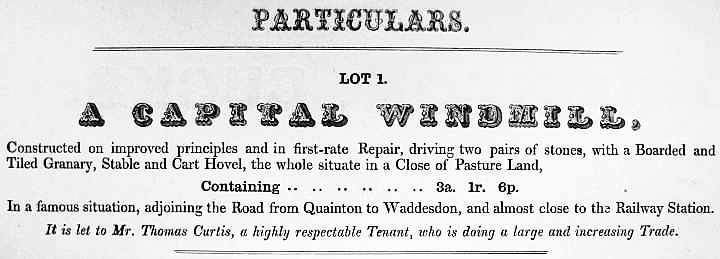
Fig. 14.9:
The auctioneer’s particulars for sale held on the 9th June, 1870, at
the White Lion Inn, Quainton.
In February 1892, the Mill was again put up for Auction — according
to the advertisement, Thomas Curtis remained the “proprietor”)
— and in September 1897 it was advertised to let. Over a
century of milling on the site came to a close at some time around
1900, and in 1912 the mill was blown down in a gale.
Wing’s windmill is marked on the 1770 and 1788 Thomas Jeffery maps
of Buckinghamshire situated on the northern side of Aylesbury Road.
The windmill had ceased operations by 1798 when it was noted as “due
to be taken down immediately” in the Posse Comitatus of that
year.

Fig. 14.10:
Bucks Herald, 4th July 1863.
The smock mill at Wingrave stood at Windmill Farm. It had been
moved from Whitchurch in 1809 and operated at Wingrave until about
1872, when it was replaced by a steam mill elsewhere in the village.
In December, 1841, the Aylesbury News announced that . . . .
“Wingrave Windmill — the above mill having
undergone extensive repairs and improvements W. Burton begs to
inform his friends that he will work day and night (wind permitting)
to fetch up his arrears of grinding”.
The windmill’s sails evidently came very near to the ground, for it
is recorded that they once killed a passing pig.
At Wendover, a windmill is marked on maps by Jefferys (1768) and by
Andrews and Dury (1809) standing upon the high ground adjoining Hale
Road and almost opposite the east end of Chapel Lane, about a
quarter of a mile north-east of the Parish Church. The name of
the field where the mill stood is Snail Hill, but nothing else is
known about it.
These are just a few of the windmills that once graced our locality
and that gradually fell into disuse and decay as industrialisation
progressed and our way of life changed. An article in the
Home Counties Magazine (Vol. II., 1900) gives a contemporary
view of these romantic, but sadly vanishing landmarks . . . .
“With the increasing application of steam
to milling purposes, and the improved means of transport of foreign
flour, it is pretty clear that the days of windmills, if not quite
over, are rapidly becoming fewer, and at no very distant date most
of the numerous picturesque examples now left in the Home Counties
will have fallen victims to neglect and decay, or have been swept
away to make room for more utilitarian buildings. . . . the old
windmill on Mitcham Common is likely to disappear before long.
For so many years it has been one of the chief landmarks of the
Mitcham district, and especially of the heath upon which it stands,
that its removal can hardly fail to produce that feeling of regret
which is inseparable from the destruction of old and familiar
features in a landscape.”
Where a windmill has left any trace at all, it is often in nothing
more than a name, the significance of which has long been forgotten.

Fig. 14.11:
Croxley Green windmill.
Croxley Green Windmill was built c.1860. The mill was working
by wind until its sails were blown off during the 1880s, and from
1886 it was worked by steam engine only. The mill was last
used to grind wheat in 1899. The mill was equipped with four
patent sails that drove three pairs of stones. |
